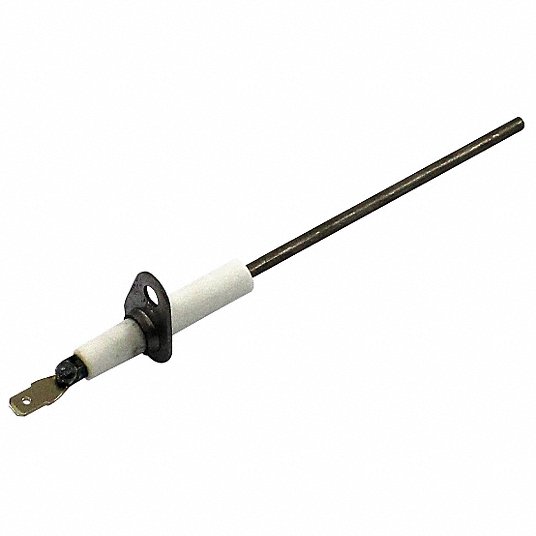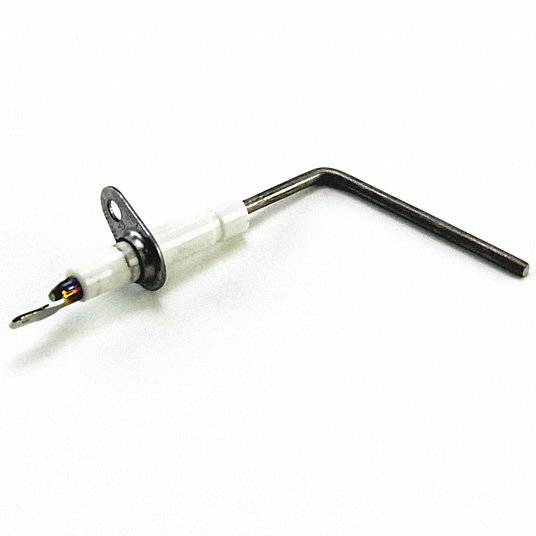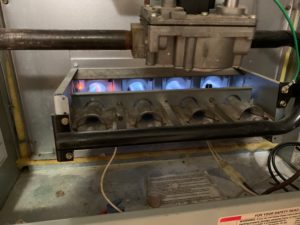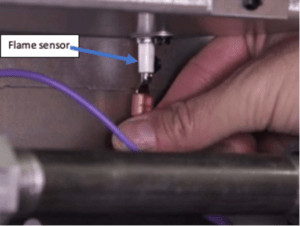A flame sensor is a safety device that detects the presence of a flame in a gas furnace. Its purpose is to prevent gas from flowing if there is no flame. If the furnace never lights, or if the flame suddenly goes out, the flame sensor will detect this and prevent gas from flowing to the furnace.
The purpose of the flame sensor is to send a signal to the gas control valve, confirming that there is actually a flame in the furnace.
Without the flame detector, the furnace would have no way of knowing if the burners have actually lit once the control valve opens to supply gas to the furnace after a call for heat. If the control valve does not receive a “flame detected” signal from flame sensor within a few seconds after opening the gas valve, it will shut the valve to stop the flow of gas to the furnace. This prevents gas from building up in the furnace and in the house if there is no flame in the furnace.
What problem does a dirty or faulty flame sensor cause?
If a furnace lights but does not detect a flame within about five seconds, it will shut off the flow of gas. After a short wait, it will attempt to light again and continue running if the furnace flame sensor detects a flame but will shut down again if no flame is detected. Normally, a furnace will attempt to light about three times before it finally shuts down for good. In other words, if the flame sensor fails to detect a flame three times, the furnace will stop attempting to light. This lighting and shutting off multiple times is called short cycling.
Sometimes, short cycling occurs because there is actually no flame in the furnace. A more common problem is a faulty flame sensor. With a faulty sensor, the furnace will actually light, but the flame sensor will not detect the flame, and will, therefore, not send the signal to the furnace to keep the gas flowing.
As described above, without this signal, the flow of gas will be shut down, stopping the flame. If your furnace is short cycling, then you need to check your flame sensor, but first you need to know where it is.
Where is the sensor located?
The furnace flame sensor is a small (often bent) piece of metal. Here are some photos of some typical flame sensors.



The flame sensor is normally located where it will be within the flame, but on the opposite side of the burner area from the pilot light or the ignitor. The photos below all show the same furnace. There are close up photos of the igniter and the sensor, then there is a photo of the entire burner area showing where both the igniter and the sensor are located.




As you can see in the photo above, the sensor is on the opposite side of the burner area from the igniter. If it were on the same side as the igniter, it would be possible for there to be a flame in the burner near the igniter, but not in the other burners. This would prevent it from properly doing its job of ensuring that all burners are lit. By placing it on the opposite side from the igniter, it ensures that all burners have ignited before the sensor will detect a flame.
How to remove a flame sensor
 In order to clean or replace the flame sensor, you need to remove it from the furnace. In order to do this, you need to ensure that the furnace will not come on while you are working on it. Otherwise, you could get a serious burn. The best way to do this is to turn off the breaker that provides power to the furnace, and to turn off the gas to the furnace.
In order to clean or replace the flame sensor, you need to remove it from the furnace. In order to do this, you need to ensure that the furnace will not come on while you are working on it. Otherwise, you could get a serious burn. The best way to do this is to turn off the breaker that provides power to the furnace, and to turn off the gas to the furnace.
There is normally only one screw holding the sensor in place. The screw is often a ¼-inch hex head screw. Loosen this screw and then slide the furnace flame sensor out of the bracket. If the wire holding the sensor in place is too short to allow you to easily access and examine the sensor, you will need to disconnect the wire from the flame sensor. (See the photo on the right.)
Now examine the sensor. If you see any cracks in it, it needs to be replaced. If there are no cracks, then it may need to be cleaned.
If you see any black buildup (carbon deposits) on the sensor, or if it is glazed over (shiny) then it needs to be cleaned.
How to clean a dirty flame sensor
In order to clean the flame sensor, you will need some fine grit sandpaper, some steel wool, or a steel brush. Use one of the above-listed items to clean the sensor. Don’t use much force or you may damage the sensor and have to replace it. Lightly rub it a few times to clean it. Once it has been cleaned, replace it by reversing the procedure above that you used to remove it.
Now turn the gas back on and turn the breaker back on. Turn your furnace on and see if it works now. Odds are that it needed to be cleaned, and that you furnace will now work. If it doesn’t work, you have two options: 1) you can replace it as described above, or 2) you can call an HVAC technician to come look at your furnace and see what’s going on.
How to replace a faulty sensor
If you see any cracks or other damage on the furnace flame sensor, it will need to be replaced. You will need to purchase a new flame sensor. They normally cost between about $10 and $30. This is not something that you would normally find at your local home improvement store. You will likely have to go to a store that specializes in heating and air conditioning equipment. You can also find them on Amazon.com.
Once you have your new flame sensor, it is a simple matter of removing the sensor as described above, disconnecting the wire from the old flame sensor, plugging the wire into the new sensor, sliding the sensor into the bracket, and tightening the screw.
Once this is done, turn your furnace on and see if it works now. Your furnace will probably work now, but if it does not, then it is time to call an HVAC technician to come look at your furnace and see what the problem is.
Here is a link to a helpful video that shows how to replace a flame sensor.
What is the difference between a flame sensor and a thermocouple?
The terms “flame sensor” and “thermocouple” are sometimes used interchangeably. Although, they work on the same principle to detect heat or a flame, they are not the same. If your furnace uses an electronic ignitor rather than a pilot light, then it uses a flame sensor to detect the flame and signal the controller that the furnace has, indeed, lit.
Thermocouples are used on older furnaces with a standing pilot light.
The thermocouple is located within the flame of the pilot light and sends a signal to the controller to keep the gas flowing to the pilot light in order to keep the pilot light lit.
See our blog on thermocouples for more information.
© 2020 Mike Morgan
This article was written by Mike Morgan, the owner of Morgan Inspection Services. Morgan Inspection Services has been providing home, septic and well inspection services throughout the central Texas area since 2002. He can be reached at 325-998-4663 or at mike@morganinspectionservices.com. No article, or portion thereof, may be reproduced or copied without prior written consent of Mike Morgan.

